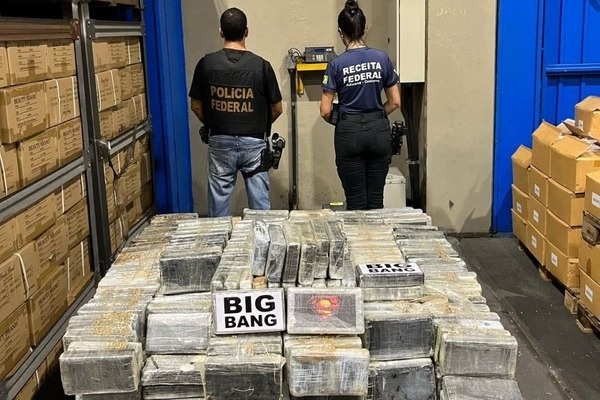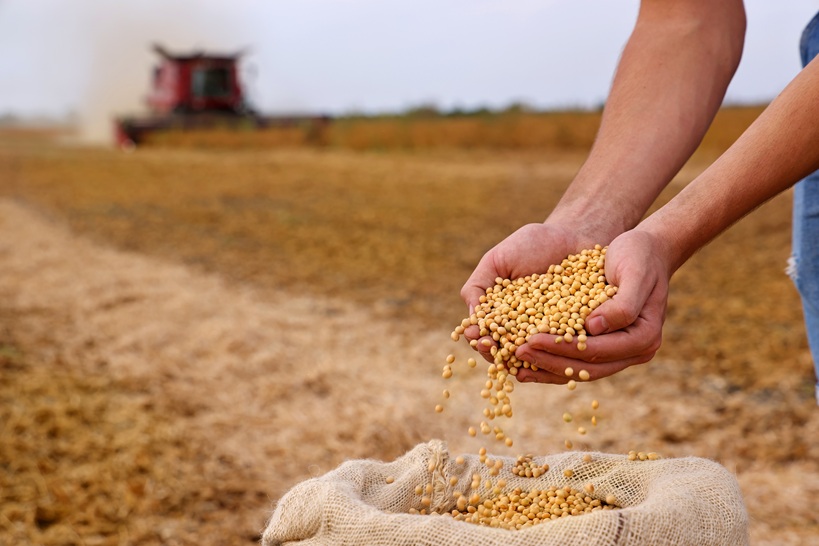
Increase in cocaine seizures in Brazil
read more

Recent assessments from both Brazilian and US federal agricultural agencies predict record soya bean production and exports this season
In its last crop assessment report released last week, the National Supply Company (CONAB) maintained its previous forecasts for a bumper crop in the 2024/25 season. Brazilian agricultural production is expected to reach a remarkable 325.7 million tonnes (Mmt), reflecting a 9.4% increase compared to the past cycle. This growth is chiefly driven by high volumes of soya beans, maize (corn), and rice.
As soya bean planting nears completion across the country, CONAB estimates that the planted area has expanded to 47.5 million hectares, marking a 2.8% increase from the 2023/24 cycle. Figure 1

Although there have been delays in the start of sowing and a slow beginning of harvesting in certain regions, the expected yield is projected to reach 3.5 kg/ha, which is a notable 9.3% higher than last season. This leads to a forecasted record production of 166 Mmt, up 12.4% from last season and 4.3% above the previous record set in the 2022/23 crop.
In an even more optimistic outlook, the United States Department of Agriculture (USDA) forecasts that Brazilian soya bean production will reach 169 Mmt this season. In comparison, the two other major global soya bean producers, the United States and Argentina, are expected to harvest 119 Mmt and 49 Mmt, respectively. Figure 2

The increased production is attributed to a combination of factors, including expanded planted areas, advancements in farming technology and favourable climate conditions in key producing regions, particularly in the grain powerhouse state of Mato Grosso in the Central-West region, which alone accounts for nearly a third of the national soya bean output.
Soya beans remain Brazil’s leading agricultural commodity. The versatile oilseed is a crucial driver of the national agribusiness sector and the economy, consistently contributing to maintaining the country’s positive trade balance. Last year, it ranked just behind petroleum in export revenues and second to iron ore in terms of gross weight exports.
Both CONAB and the USDA project that, despite delays in sowing and harvesting, Brazil will export around 105.5 Mmt of soya beans during the current season, followed by the United States (49.7 Mmt), Paraguay (7.3 Mmt), Canada (4.8 Mmt), and Argentina (4.5 Mmt).
China will continue to be the world’s top soya bean buyer, primarily importing from Brazil, with shipments estimated at 109 Mmt, down 2.7% from last season. Meanwhile, the European Union remains the second-largest importer of the oilseed, with purchases estimated to reach 14.6 Mmt, an increase of 8.5% compared to the 2023/24 cycle.
According to data released earlier this week by the National Agency of Waterway Transport (ANTAQ), in 2024, 122.5 Mmt of soya beans were shipped from Brazil, down 3% from the previous year. The leading exporting port complexes were Santos, with a share of 29% of the volumes, Itaqui (14%), Paranaguá-Antonina (14%), Rio Grande (11%), and Vila do Conde (Barcarena) (10%). Figures 3 & 4

FOB shipments amounted to US$ 42.9 billion, a 19% decrease from 2023, amid lower international prices and reduced production in the last crop. Notably, for the first time, oil and oil products surpassed soya beans as the primary, top-grossing commodity in Brazil’s export basket. Figure 4

The average FOB value throughout 2024 was US$ 0.4/Kg, 20% lower than the average price in the previous year. Figure 5

In 2024, approximately 13% of the soya beans exported were pre-carried in barges sailing down the Amazon’s inland waterways. Barge convoys typically depart from cargo transhipment stations in Porto Velho, on the Madeira River, and Miritituba (Itaituba), on the Tapajós River. These barges head to grain ports downstream on the Amazon River, including Itacoatiara, Santarém, Vila do Conde (Barcarena), and Santana (Macapá). Once the barges reach the river ports, the cargo is unloaded either into shore silos or directly onto bulk carriers. Figure 6

Last year, the Amazon ports collectively handled about 17 Mmt of soya bean, marginally less than in 2023. Vila do Conde stood out as the main exporting port in the North region, accounting for more than half of the volumes shipped. Shipments peaked between February and June but saw a dramatic decline in the second half of the year due to severe drought conditions that affected the region, hindering the barging of grains to the ports.
In 2024, Despite the challenging climatic event, the opening of the Novo Remanso Port Terminal – a new facility on the right bank of the Amazon River near the existing grain port of Itacoatiara – combined with increased throughput at the grain terminals in Vila do Conde, significantly helped mitigate the logistic disruptions caused by the drought.
Meanwhile, without relying on inland waterways, the thriving port of Itaqui in Sao Luis continues to expand and increase its productivity. The Northeastern port stood out the most in the so-called Northern Arc, exporting 13.7 Mmt of the oilseed last year, which accounted for 14% of the total volume shipped. The seaport in the state of Maranhão ranks second only to the port complex of Santos, which handled 27.9 Mmt, nearly 29% of all soya bean shipments in 2024. While Itaqui’s throughput increased by 5% compared to the previous year, Santos experienced a drop of almost 9% in the volume of soya beans handled during the same period.
Albeit at a lower rate, soya bean shipments departing from Brazilian ports in 2024 were consistent with the monthly port handling recorded during the same period in the previous year, with shipments peaking from February to June and declining from July to December. Figure 7

In line with previous years’ sales trends, approximately 73% of all Brazilian soya bean exports last year were shipped to China. Other top destinations included Spain (4.2%), Thailand (3.6%), Turkey (2.3%) and Iran (1.9%). Figure 8

In addition to foreign materials and free fatty acids (FFA), critical quality factors for safe handling, storage, and sea carriage of soya beans include the cargo moisture content (MC) and cargo temperature at the time of loading.
The soya bean sales contracts drafted by the National Association of Grain Exporters (ANEC), which Brazilian shippers widely adopt, specify a maximum MC of 14%, which aligns with current recommendations of the Brazilian Ministry of Agriculture, Supply and Livestock (MAPA). However, P&I clubs and international commodity scientists consider this limit to be excessively high.
Soya beans with high moisture content and elevated cargo temperature are biologically unstable. They can be prone to self-heating during transportation, particularly on long voyages from Brazil to Asian ports, which can take up to 45 days, plus additional waiting time at the anchorage of the port of discharge and the time taken to unload the cargo. The longer the transit time – and the higher the MC and cargo temperature – the greater the risk of cargo deterioration.
Our publication, Loading Soya Beans in Brazil – Practical Guidance, provides comprehensive information on loss prevention measures that shipowners, masters and crews can implement to safely load and transport this valuable agricultural commodity across the seas.
Please read our disclaimer.
Related topics:
Rua Barão de Cotegipe, 443 - Sala 610 - 96200-290 - Rio Grande/RS - Brazil
Telephone +55 53 3233 1500
proinde.riogrande@proinde.com.br
Rua Itororó, 3 - 3rd floor
11010-071 - Santos, SP - Brazil
Telephone +55 13 4009 9550
proinde@proinde.com.br
Av. Rio Branco, 45 - sala 2402
20090-003 - Rio de Janeiro, RJ - Brazil
Telephone +55 21 2253 6145
proinde.rio@proinde.com.br
Rua Professor Elpidio Pimentel, 320 sala 401 - 29065-060 – Vitoria, ES – Brazil
Telephone: +55 27 3337 1178
proinde.vitoria@proinde.com.br
Rua Miguel Calmon, 19 - sala 702 - 40015-010 – Salvador, BA – Brazil
Telephone: +55 71 3242 3384
proinde.salvador@proinde.com.br
Av. Visconde de Jequitinhonha, 209 - sala 402 - 51021-190 - Recife, PE - Brazil
Telephone +55 81 3328 6414
proinde.recife@proinde.com.br
Rua Osvaldo Cruz, 01, Sala 1408
60125-150 – Fortaleza-CE – Brazil
Telephone +55 85 3099 4068
proinde.fortaleza@proinde.com.br
Tv. Joaquim Furtado, Quadra 314, Lote 01, Sala 206 - 68447-000 – Barcarena, PA – Brazil
Telephone +55 91 99393 4252
proinde.belem@proinde.com.br
Av. Dr. Theomario Pinto da Costa, 811 - sala 204 - 69050-055 - Manaus, AM - Brazil
Telephone +55 92 3307-0653
proinde.manaus@proinde.com.br
Rua dos Azulões, Sala 111 - Edifício Office Tower - 65075-060 - São Luis, MA - Brazil
Telephone +55 98 99101-2939
proinde.belem@proinde.com.br